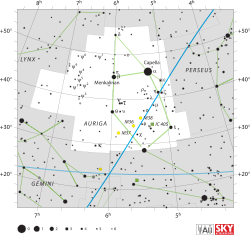Kappa Aurigae

| |
| Observation data Epoch J2000 Equinox J2000 | |
|---|---|
| Constellation | Auriga |
| Right ascension | 06h 15m 22.68906s[1] |
| Declination | +29° 29′ 53.0760″[1] |
| Apparent magnitude (V) | 4.335[2] |
| Characteristics | |
| Spectral type | G8.5 IIIb[3] |
| U−B color index | +0.812[2] |
| B−V color index | +1.023[2] |
| R−I color index | 0.54 |
| Astrometry | |
| Radial velocity (Rv) | +20.69 ± 0.15[4] km/s |
| Proper motion (μ) | RA: -70.88[1] mas/yr Dec.: -261.42[1] mas/yr |
| Parallax (π) | 19.31 ± 0.83[1] mas |
| Distance | 169 ± 7 ly (52 ± 2 pc) |
| Details | |
| Radius | 11[4] R☉ |
| Luminosity | 54[4] L☉ |
| Surface gravity (log g) | 2.7[4] cgs |
| Temperature | 4,732[4] K |
| Metallicity [Fe/H] | –0.33[4] dex |
| Rotational velocity (v sin i) | 2.5[4] km/s |
| Other designations | |
Kappa Aurigae (κ Aur, κ Aurigae) is the Bayer designation for a star in the northern constellation of Auriga. It is visible to the naked eye with an apparent visual magnitude of 4.3.[2] Based upon an annual parallax shift of 19.31 mas,[1] it is approximately 169 light-years (52 parsecs) distant from Earth.
This is an evolved giant star with a stellar classification of G8.5 IIIb.[3] It is a red clump star that is generating energy through the fusion of helium at its core.[6] Kappa Aurigae has expanded to 11 times the radius of the Sun and shines with 54 times the Sun's luminosity. This energy is radiated into outer space from the outer envelope at an effective temperature of 4,732 K.[4] At this heat, the star glows with the orange-hue of a G-type star.[7]
References
- 1 2 3 4 5 6 van Leeuwen, F. (November 2007), "Validation of the new Hipparcos reduction", Astronomy and Astrophysics, 474 (2): 653–664, arXiv:0708.1752
 , Bibcode:2007A&A...474..653V, doi:10.1051/0004-6361:20078357.
, Bibcode:2007A&A...474..653V, doi:10.1051/0004-6361:20078357. - 1 2 3 4 Jennens, P. A.; Helfer, H. L. (September 1975), "A new photometric metal abundance and luminosity calibration for field G and K giants.", Monthly Notices of the Royal Astronomical Society, 172: 667–679, Bibcode:1975MNRAS.172..667J, doi:10.1093/mnras/172.3.667.
- 1 2 Eggleton, P. P.; Tokovinin, A. A. (September 2008), "A catalogue of multiplicity among bright stellar systems", Monthly Notices of the Royal Astronomical Society, 389 (2): 869–879, arXiv:0806.2878
 , Bibcode:2008MNRAS.389..869E, doi:10.1111/j.1365-2966.2008.13596.x.
, Bibcode:2008MNRAS.389..869E, doi:10.1111/j.1365-2966.2008.13596.x. - 1 2 3 4 5 6 7 8 Massarotti, Alessandro; et al. (January 2008), "Rotational and Radial Velocities for a Sample of 761 HIPPARCOS Giants and the Role of Binarity", The Astronomical Journal, 135 (1): 209–231, Bibcode:2008AJ....135..209M, doi:10.1088/0004-6256/135/1/209.
- ↑ "NLTT 8982 -- High proper-motion Star", SIMBAD Astronomical Database, Centre de Données astronomiques de Strasbourg, retrieved 2012-07-18.
- ↑ Alves, David R. (August 2000), "K-Band Calibration of the Red Clump Luminosity", The Astrophysical Journal, 539 (2): 732–741, arXiv:astro-ph/0003329
 , Bibcode:2000ApJ...539..732A, doi:10.1086/309278.
, Bibcode:2000ApJ...539..732A, doi:10.1086/309278. - ↑ "The Colour of Stars", Australia Telescope, Outreach and Education, Commonwealth Scientific and Industrial Research Organisation, December 21, 2004, retrieved 2012-01-16.